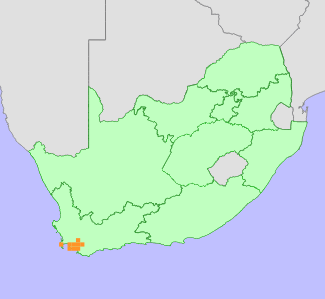|
Scientific Name | Serruria inconspicua L.Guthrie & T.M.Salter |
Higher Classification | Dicotyledons |
Family | PROTEACEAE |
Common Names | Cryptic Spiderhead (e) |
National Status |
Status and Criteria | Near Threatened B1ab(iii)+2ab(iii) |
Assessment Date | 2020/06/29 |
Assessor(s) | A.G. Rebelo, H. Mtshali & L. von Staden |
Justification | Serruria inconspicua has a restricted distribution range, with an extent of occurrence (EOO) of 2479 km², and an area of occupancy (AOO) of 312-316 km². It is still locally common, occurring at more than 10 locations, but a continuing decline is inferred from ongoing habitat loss to agricultural expansion, and competition from alien invasive plants. Therefore it nearly meets the criteria thresholds for Vulnerable under criterion B and is listed as Near Threatened. |
Distribution |
Endemism | South African endemic |
Provincial distribution | Western Cape |
Range | This species has a restricted distribution in the Western Cape Province, South Africa, where it occurs from the Cape Peninsula to Shaws Pass. |
Habitat and Ecology |
Major system | Terrestrial |
Major habitats | Peninsula Sandstone Fynbos, South Sonderend Sandstone Fynbos, Overberg Sandstone Fynbos, Kogelberg Sandstone Fynbos, Elgin Shale Fynbos, Elim Ferricrete Fynbos, Western Coastal Shale Band Vegetation |
Description | It grows in sandstone and shale fynbos, on dry slopes and flats. Mature individuals are killed by fires, and only seeds survive. Seeds are released after ripening, and dispersed by ants to their underground nests, where they are protected from predation and fire. It is pollinated by insects. |
Threats |
| About 28% of this species habitat is irreversibly modified, and loss continues. The main cause of habitat loss is agricultural expansion, predominantly vineyards and wheat cultivation. In small lowland remnants, it is exposed to agricultural chemicals.
The Shaw's Pass, Caledon Swartberg and Riviersonderend are densely invaded with invasive plants (hakeas, acacias and pines) and natural fynbos is becoming increasingly degraded, leading to declines of rare and localized native species. |
Population |
Serruria inconspicua prefers rich soils and appears to have been eliminated from suitable habitat in the Elgin basin and Caledon Swartberg. It is still locally common, often occurring in dense stands. Population decline is inferred from recent habitat loss and competition from alien invasive plants.
|
Population trend | Decreasing |
Conservation |
| It is conserved in the Kogelberg and Houwhoek Nature Reserves. |
Notes |
| It is often confused with its sister species Serruria fasciflora. It appears that Serruria inconspicua sensu stricto occurs on the Cape Peninsula, the southern Elgin basin, and Dassiesfontein ridge, but isolated plants with Serruria inconspicua features occur as far as Shaw’s Pass, Caledon Swartberg, Wolfieskop (Riviersonderend) and Kweekkraal (Stettynsberg). |
Assessment History |
Taxon assessed |
Status and Criteria |
Citation/Red List version | | Serruria inconspicua L.Guthrie & T.M.Salter | VU A2c | Raimondo et al. (2009) | | Serruria inconspicua L.Guthrie & T.M.Salter | Not Threatened | Hilton-Taylor (1996) | |
Bibliography |
Goldblatt, P. and Manning, J.C. 2000. Cape Plants: A conspectus of the Cape Flora of South Africa. Strelitzia 9. National Botanical Institute, Cape Town.
Hilton-Taylor, C. 1996. Red data list of southern African plants. Strelitzia 4. South African National Botanical Institute, Pretoria.
Manning, J.C. and Goldblatt, P. 2012. Plants of the Greater Cape Floristic Region 1: The Core Cape Flora. Strelitzia 29. South African National Biodiversity Institute, Pretoria.
Raimondo, D., von Staden, L., Foden, W., Victor, J.E., Helme, N.A., Turner, R.C., Kamundi, D.A. and Manyama, P.A. 2009. Red List of South African Plants. Strelitzia 25. South African National Biodiversity Institute, Pretoria.
Rebelo, T. 2001. Sasol Proteas: A field guide to the proteas of southern Africa. (2nd ed.). Fernwood Press, Vlaeberg, Cape Town.
|
Citation |
| Rebelo, A.G., Mtshali, H. & von Staden, L. 2020. Serruria inconspicua L.Guthrie & T.M.Salter. National Assessment: Red List of South African Plants version . Accessed on 2025/04/13 |
 Comment on this assessment
Comment on this assessment

